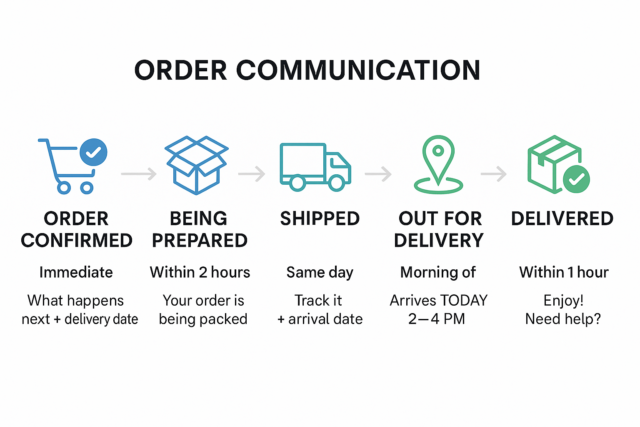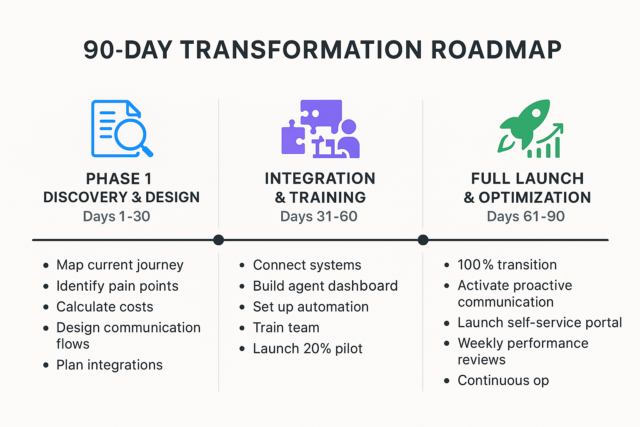Order management can make or break your customer relationships—and here’s proof: At 2 AM, your customer Sarah checks her phone for the fifth time asking herself, “Where’s my order?” It was supposed to arrive yesterday. She opens your app—no update. She calls your support line, but it’s closed. She vents on Twitter. You just lost a $15,000 lifetime value customer over a $50 order.
This scenario plays out thousands of times daily across e-commerce brands worldwide. “Where’s my order?” (WISMO) inquiries eat up 30-40% of all customer service tickets. Yet most brands treat order support as a boring back-office function instead of the profit driver it could be.

The numbers tell a tough story: 69% of customers won’t buy from you again after one bad delivery experience, and 43% say poor order status communication frustrates them most. But here’s the bright side: brands with proactive order communication see 25% higher customer retention.
In this article, you’ll discover seven proven strategies that top contact centers use to turn order management from a complaint magnet into a loyalty machine—and why outsourcing delivers results faster than building it yourself.
THE ORDER MANAGEMENT-CX DISCONNECT: WHY PERFECT OPERATIONS STILL CREATE FRUSTRATED CUSTOMERS
Your warehouse might be humming along beautifully. Orders get picked and packed in two hours. Accuracy hits 99.5%. Same-day shipping? Check. Yet somehow, your customers are still unhappy.
Here’s why: Customers don’t care about your warehouse metrics. They care about one thing—knowing where their order is and when it’ll arrive.
The problem isn’t your operations. It’s the communication gap.
What Operations Sees vs. What Customers Experience
Let’s look at the disconnect:
Your operations dashboard says: “Order shipped on time ✓“
Your customer thinks: “Wait, it shipped? Nobody told me.“
Your warehouse celebrates: “Standard 3-5 day delivery achieved“
Your customer wonders: “So… 3 days? Or 5 days? Which is it?“
Your system notes: “Package delayed due to weather.“
Your customer discovers: “My order is late and nobody warned me. Do they even care?“
To make it easier, we use a color code throughout the article: blue for what the customer says or thinks, and green for the CX messages that are said or sent to the customers. This gap destroys trust. Fast. According to Forrester research, 73% of WISMO tickets are preventable with better communication. For a brand processing 10,000 orders monthly with a typical 35% WISMO rate, that’s 2,500+ frustrated customers every single month who didn’t need to call at all.
The winning brands in 2026 aren’t shipping faster—they’re communicating smarter. They’re investing in contact centers that make great logistics visible to customers.
THE 7 CX-DRIVEN STRATEGIES THAT BOOST ORDER PROFITABILITY
These aren’t generic tips. These are battle-tested strategies used by contact centers that have transformed order chaos into customer delight.

Strategy #1 – Master Proactive Order Communication
(Say Goodbye to WISMO)
Here’s the old, broken pattern:
Customer orders → radio silence → customer worries → customer calls → agent scrambles → customer frustrated.
When 35-40% of your contact center’s resources are dedicated to handling “Where’s my order?” calls, you’re burning resources that could be used to build relationships and drive sales.
The Five-Stage Proactive Framework
Smart contact centers flip the script with proactive communication at every step:
Stage 1: Order Confirmation (Immediate)
Instead of a boring “order received” email, send excitement: “Order received! Here’s what happens next…” Include specific delivery dates (not vague “3-5 days”), and give them an easy tracking link right away.
Stage 2: Order Processing (Within 2 Hours)
Send a quick update: “Great news! Your order is being prepared…” Some brands even include photos of the packed box—it humanizes everything.
Stage 3: Shipped (The Second It Leaves)
“Your order is on its way! Track it here…” with the precise delivery date, carrier info, and what to do if they’re not home. Real information, not mystery.
Stage 4: Out for Delivery (Morning Of)
“Your order arrives TODAY! Estimated time: 2-4 PM.” This stops the anxious checking and builds anticipation.
Stage 5: Delivered (Within an Hour)
“Delivered! Enjoy your [product]. Need anything?” Quick support access if something’s wrong, plus a friendly review invitation.

Why Outsourcing Wins Here
Professional CX providers have automation platforms that integrate with over 50 e-commerce and shipping systems from the start. They offer omnichannel delivery—email, SMS, WhatsApp, and app push notifications—so customers receive updates in the way they prefer. Their messaging has been A/B tested across thousands of campaigns to maximize opens and minimize anxiety.
Real Results: One fashion e-commerce brand we worked with had 42% of support calls asking, “Where’s my order?” After outsourcing and implementing a five-stage proactive communication strategy, WISMO’s rate dropped to just 11% within 60 days. Customer satisfaction jumped from 76% to 91%.
Strategy #2 – Give Agents Real-Time Order Visibility
(No More “Let Me Check…”)
Picture this painful scenario:
Customer: “Where’s my order?“
Agent: “Um, let me check… I need to look in a few systems… Can I call you back?“
Customer’s brain: “They don’t even know where my stuff is??“
Trust: destroyed.
According to Zendesk research, 65% of customers say being transferred or put on hold is their biggest frustration. In 2026, this is entirely fixable.
The Unified Order Dashboard
Top contact centers give agents one screen with everything:
- Real-time status: Processing, shipped, out for delivery, delivered, delayed—no guessing.
- Complete history: Every past purchase, return, and interaction with this customer.
- Live tracking: Actual carrier location, not just “shipped.”
- Smart alerts: System flags weather delays, inventory issues, or address problems before customers call.
- Communication log: What automated messages did the customer already get? No repeating information.
- One-click actions: Resend tracking, update addresses, start returns, escalate to warehouse—all instant.

The Experience Difference
Without visibility (8-12 minute call):
“Let me get your order number… hold on… I need to check with shipping… let me transfer you…“
With visibility (2-3 minute call):
“I see it right here, Sarah! Your package is in Memphis right now and arrives tomorrow by 4 PM. Want me to text you the live tracking link?“
Same question. Totally different experience.
Outsourced CX providers invest millions in integrated platforms with pre-built connectors to Shopify, WooCommerce, Amazon, FedEx, UPS, and major ERPs. Building this yourself takes 12 to 18 months. They deploy it in 30 days.
Strategy #3 – Turn Order Problems Into Loyalty Moments
(The Service Recovery Magic)
Here’s something counterintuitive but proven true: A customer whose problem gets fixed quickly becomes MORE loyal than someone who never had a problem. Harvard Business Review calls this the “Service Recovery Paradox.”
Things go wrong with orders. Carriers delay packages. Addresses get mistyped. Products arrive damaged. That’s reality.
The magic happens in how your contact center responds.
Detect Issues Before Customers Notice
Smart systems monitor for trouble:
- Carrier tracking shows a 2-day delay
- Inventory shortage means an item won’t ship on time
- Delivery failed because the customer wasn’t home

Reach Out Proactively (Don’t Wait for Angry Calls)
The Wrong Way (Reactive):
Customer calls 3 days after the expected delivery. The agent apologizes and investigates. Damage done—customer already told five friends how terrible you are.
The Right Way (Proactive):
Day before the delay: “Hi Sarah, heads up—your order might arrive a day late because of weather in Chicago. We’ve upgraded you to express shipping at no charge, and you’ll get it by [new date]. Here’s 15% off your next order as our apology.“
The psychology is powerful:
- Customer feels valued, not forgotten
- You take responsibility before being forced to
- Customer gets compensation before complaining
Empower Agents to Fix Things Fast
Elite CX agents can:
- Issue refunds (up to approved limits) without asking permission
- Send replacement orders with expedited shipping
- Provide discount codes for future purchases
- Upgrade shipping for delayed orders
- Offer alternative products when items are unavailable
No “let me ask my manager” delays. Just solutions.
The math works: Without service recovery, a customer with a problem has a 30% chance of buying again. With excellent recovery, that jumps to 82%. For a customer with a lifetime value of $2,000, each successful recovery saves $1,640 in future revenue.
Specialized CX providers train agents extensively in empathy-driven service recovery. Their teams have seen every order disaster scenario and know exactly how to fix it.
Strategy #4 – Optimize Post-Purchase Communication
(The Overlooked Gold Mine)
Most brands obsess over pre-purchase: ads, website design, checkout optimization. Then the order is placed and… crickets.
Huge missed opportunity.
The post-purchase window from “order placed” to “product received” contains 5-10 customer touchpoints. Each one is a chance to build excitement, trust, and loyalty. Mess it up, and customers might love your product but never return because the journey to get it felt cold and impersonal.
The CX Communication Architecture
Day 1: Order Confirmation (Build Excitement)
“You’re going to love your [product]!” Not boring. Exciting. Include the specific arrival date, easy tracking, and bonus content: “Here’s how to get the most out of your purchase” with setup tips or an unboxing video.
Days 2-3: Preparation Updates (Build Anticipation)
“Your order is being carefully prepared…”
Day 4: Shipped (Build Transparency)
“It’s on its way!” with live tracking, delivery window, and helpful guidance: “Not home? Here’s how to redirect delivery.“
Day of Delivery: Final Mile (Build Excitement)
Morning: “Arrives TODAY between 2-6 PM“
After delivery: “Delivered! Open it up!“
Immediate support access: “Any issues? We’re here 24/7“
Day After Delivery: Experience Check (Show You Care)
“How’s everything? Love your [product]?” If they respond positively, then invite a review. If negative, address the issue immediately.
Week 2: Engagement (Build Relationship)
“Getting the most from your [product]? Here are 3 insider tips…” Plus helpful (not pushy) cross-sell: “Complete your setup with these accessories.“

The Outsourcing Advantage
CX providers have pre-built post-purchase journeys tested across thousands of brands. They offer omnichannel delivery, so customers receive messages in the way they prefer. Sentiment analysis triggers human intervention whenever customers express concern. Continuous A/B testing optimizes open rates and engagement.
The results? Well-executed post-purchase communication increases repeat purchases by 18-25%, boosts review submissions by 35-40%, and cuts “how do I use this?” support calls by 30%.
Strategy #5 – Create Self-Service Order Intelligence
(Smart Support That Frees Your Team)
Let’s be clear about something important: self-service isn’t about replacing human agents. It’s about freeing them to focus on interactions where human empathy and creativity really matter.
Think about it: When customers have simple questions like “Where’s my package right now?“, they often prefer instant answers over waiting for an agent. But when they’re upset about a damaged item or confused about a complex return, they want—and deserve—a caring human expert immediately.
Intelligent Self-Service Components
Component 1: Smart Order Tracking Portals
Basic tracking is useless: “Your package is in transit” tells customers nothing of value.
Intelligent tracking shows:
- Map view of the package journey and current location
- Countdown timer: “Arrives in 23 hours“
- Custom notifications: “Text me when out for delivery“
- Delivery preferences: “Leave at back door” or “Signature required“
- One-click actions: Reschedule delivery, change address, request hold
Component 2: Conversational AI for Simple Questions
Smart chatbots handle routine inquiries instantly:
- “Where’s my order?” → Live tracking with visual map
- “When will it arrive?” → Specific date/time from real data
- “Can I change my address?” → System update (if timing allows)
- “How do I return this?” → Return label generated immediately
When Humans Take Over
The critical part: knowing when to escalate to human agents.
Transfer immediately when:
- Issues are complex (damaged items, wrong products)
- Customers are emotional (upset, frustrated, anxious)
- Requests need creativity (special accommodations)
- The bot can’t help after 2 attempts
Component 3: Context-Aware Help Centers
Smart knowledge bases that read the situation:
- Customer viewing order status → “Need to change delivery address? Click here“
- Order shows delay → “Delayed packages: What to expect and our guarantee“
- Return initiated → “Return process timeline + how refunds work“
Why Outsourcing Makes Sense
CX providers have enterprise AI platforms that would cost hundreds of thousands to build yourself. Their models are pre-trained on millions of order inquiries, delivering accurate answers from day one. Continuous learning across all clients means the AI gets smarter with every single interaction. Plus, 24/7 availability without staffing night shifts.
The real win? Agents spend time solving genuine problems and building relationships instead of reading tracking numbers from screens. This creates more satisfying work for agents and more valuable interactions for customers. It’s about better support, not fewer people.
Strategy #6 – Master Returns & Exchanges as Retention Tools
(Your Second Chance to Win)
E-commerce return rates range from 20-30% across most industries, with the fashion sector sometimes reaching 40%. Most brands see returns as “lost sales” and treat them like annoying paperwork.
Smart brands view returns as second chances to demonstrate their care.

Make Returns Ridiculously Easy
What customers want:
- Instant approval: No waiting 24 hours for someone to “review your request”
- Automatic labels: Email arrives in seconds
- Multiple options: Drop-off, pickup, or mail—customer’s choice
- Fast refunds: Credit is issued when the carrier scans the return package, not days later when your warehouse opens it
- Easy exchanges: Send the replacement before the return arrives
The Contact Center’s Role
Tier 1: Self-Service Returns (80% of Cases)
Customer clicks “Return item” → selects reason → gets label instantly. Done. No agent needed for straightforward “wrong size” returns.
Tier 2: Assisted Returns (20% – Complex Cases)
Agent helps when customers are unsure. Here’s where the magic happens:
“Would a different size work better?” (Offer exchange, not refund)
“This style runs small—customers love our [alternative] instead” (Suggest better options)
About 30-40% of customers considering returns will accept exchanges when offered thoughtfully. Exchange = revenue retained. Happy customer retained.
Returns Intelligence: The Feedback Loop
Elite CX teams track:
- Return reasons by product (quality issues?)
- Return patterns by customer segment (do first-time customers return more?)
- Return trends by season (do holiday gifts yield higher returns?)
- Photos of returned items (is the online listing accurate?)
Actionable example: CX team discovers “Product X has 35% return rate for ‘too small.'” They tell merchandising: “Update the sizing chart and add customer photos.” Return rate drops to 18% within a month. Significant revenue saved.
Outsourced CX providers offer return platforms with automatic label generation, cross-brand intelligence on what works, exchange optimization algorithms, and real-time analytics dashboards that track trends.
The retention numbers are clear: customers who return products with easy, empathetic service have an 85% chance of shopping with the company again. Frustrating returns? Only 29% return. For a customer with a lifetime value of $1,800, every smooth return experience preserves substantial future revenue.
Strategy #7 – Build Omnichannel Order Support
(Meet Customers Where They Want to Talk)
Customer communication preferences in 2026 are more diverse than ever. 67% prefer self-service for simple questions, but when they need human help, they want it through their preferred channel right then.
Forcing everyone to call when some prefer texting? That’s like forcing left-handed people to write with their right hand. It works, but it’s unnecessarily complex.
How Order Inquiries Split Across Channels
SMS/Text (Quick Questions)
“Where’s my package?” They want fast answers while doing other things. Great teams respond in under 60 seconds.
Live Chat (Real-Time Problem Solving)
“Need to change delivery address.” They appreciate typing while working or watching kids. Screen sharing enables agents to walk users through processes visually.
Phone (Urgent or Emotional)
“My order arrived damaged and I need it tomorrow.” Voice conveys empathy that text cannot. Essential for upset customers.
Email (Non-Urgent)
“Question about return policy.” They don’t need instant answers and prefer written documentation.
Social Media (Public Complaints)
“Still waiting on my order from @YourBrand 😡” Needs a quick, visible response to protect brand reputation.
The Unified Experience
Smart contact centers use unified agent desktops where one agent sees email, chat, SMS, voice, and social media in one interface. Customer context travels across channels—when someone starts in chat and later calls, the agent knows the full story. No repeating information.
Channel-specific optimization:
- SMS excellence: “Your order arrives today 2-4 PM. Reply TRACK for location” → Customer texts “Change address” → Agent responds in 60 seconds.
- Live chat mastery: Customer on tracking page clicks “Chat with us” → Agent already sees their order, shipping status, and past contacts → Problem solved in 3-5 minutes.
- Phone expertise: Complex emotional issues get immediate human attention → Agents have authority to send overnight replacements, issue refunds, provide compensation → Empathy delivered through voice.
- Social media service recovery: Customer tweets complaint → Team responds publicly: “So sorry! DM us your order #” → Resolution happens privately → Customer often posts positive update turning complaint into endorsement.
The Outsourcing Advantage
Building an omnichannel solution yourself requires a massive investment and 12-18 months of integration. Outsourced providers deploy it in 30 days with complete technology stacks: unified desktops (Zendesk, Salesforce), SMS platforms (Twilio, RingCentral), live chat (Intercom, LivePerson), and social monitoring (Sprout Social, Hootsuite).
The impact is measurable: Customer satisfaction increases 23% when people use their preferred channel. First contact resolution improves 35% because agents have full context. Average handle time drops 28% as efficiency improves. Voice and non-voice strategies working together create better experiences than either alone.
WHY OUTSOURCING ORDER MANAGEMENT CX BEATS BUILDING IT YOURSELF
The question isn’t whether to improve order support—it’s whether to build it internally or partner with specialists. Let’s look at the honest comparison:
The In-House Path
What you need to build:
- Hire a specialized CX team (6-12 months recruitment in competitive markets)
- Integrate order systems with CX platform (between $100 K and $500 K, takes 6 to 9 months)
- Build proactive communication infrastructure (between $50 K and $200 K)
- Develop training programs (3 to 6 months)
- Implement quality assurance (ongoing)
- Create analytics dashboards (between $25 K and $100 K)
Total timeline: 18-36 months
Total investment: $500 K to $2 M+
Risk level: High (unproven, learning curves, turnover)
The Outsourcing Path
What you get immediately:
- Team trained on order management CX best practices (start delivering Day 1)
- Proven technology stack (already integrated with major platforms)
- Pre-built communication frameworks (tested across hundreds of brands)
- Established quality processes (99%+ accuracy guaranteed)
- Real-time analytics (built-in dashboards)
- Cross-brand intelligence (learn from what works everywhere)
Total timeline: 30-90 days
Total investment: Variable costs that scale with your business
Risk level: Minimal (proven methodologies, guaranteed results)
When to Consider Outsourcing
✅ Outsourcing makes sense if you:
- Process 1,000+ orders monthly
- WISMO inquiries exceed 25% of support volume
- Lack integrated order visibility for agents
- Have no dedicated order experience specialists
- Want to scale rapidly without hiring headaches
- Need 24/7 support without managing three shifts
According to Deloitte’s outsourcing survey, 70% of businesses cite cost reduction and access to specialized expertise as top reasons for outsourcing customer service functions.
Gradual integration strategies allow you to start with specific functions, such as WISMO handling or returns, and then expand as you see results.
YOUR 90-DAY TRANSFORMATION ROADMAP
Here’s how leading brands go from order chaos to CX excellence in three months:

Phase 1: Discovery & Design (Days 1-30)
Weeks 1-2: Baseline Assessment
- Map your current order customer journey
- Identify the top 10 order pain points
- Calculate current costs (support time + customer churn)
- Define success metrics (WISMO reduction %, CSAT increase)
Weeks 3-4: Process Design
- Design proactive communication flows (5-stage framework)
- Map system integrations needed
- Create agent knowledge base and SOPs
- Define escalation protocols
Phase 2: Integration & Training (Days 31-60)
Weeks 5-6: Technical Integration
- Connect order systems to the CX platform
- Build a unified agent dashboard
- Set up automated communication triggers
- Test end-to-end workflows
Weeks 7-8: Team Training & Pilot
- Train the outsourced team on your brand voice, products, and processes
- Launch pilot with 20% of order volume
- Monitor closely, gather feedback
- Refine based on real interactions
Phase 3: Full Launch & Optimization (Days 61-90)
Weeks 9-10: Full Rollout
- Transition 100% of order support to the outsourced team
- Activate proactive communication for all customers
- Launch self-service order portal
- Enable omnichannel support
Weeks 11-12: Optimization & Analysis
- Weekly performance reviews
- Adjust communication timing and messaging
- Identify process bottlenecks
- Celebrate wins with the team!
Critical success factors
- Executive sponsorship (this is strategic, not just tactical),
- cross-functional collaboration (operations, marketing, CX must align),
- customer communication (be transparent about improvements),
- and continuous iteration (test, learn, optimize monthly).
THE BOTTOM LINE: ORDER CX IS YOUR 2026 COMPETITIVE EDGE
Here’s the truth: In 2026, logistics excellence is table stakes. Every brand can ship orders efficiently. But customer experience around orders? That’s the new battlefield.
The brands winning aren’t shipping faster—they’re communicating better, anticipating problems better, and recovering from issues better.
Think about the opportunity cost. Every “Where’s my order?” call you get represents a customer whose trust you’re rebuilding instead of strengthening. Every proactive update you could send but don’t is a missed chance to show you care. Every customer who leaves after one bad delivery takes their $1,800 lifetime value to your competitor.
Three Actions You Can Take Today
- Audit your WISMO rate: Calculate what percentage of support volume is order-related. Leading brands target under 15%.
- Map your post-purchase communication: Count touchpoints between purchase and delivery. How many do you have? How proactive are they?
- Calculate your order CX cost: Add support time on order inquiries plus estimated revenue lost from customers who don’t return after poor experiences.
If you could eliminate 40% of support volume while increasing customer satisfaction 25%, what would your business look like in 12 months?
Transform Your Order Experience With NAOS CX
Order management isn’t a logistics problem—it’s a customer experience opportunity. The seven strategies we’ve covered show how modern contact centers transform every order touchpoint into moments that build trust and loyalty:
- proactive communication that prevents “Where’s my order?” calls,
- real-time visibility that empowers instant answers,
- service recovery that turns problems into wins,
- post-purchase engagement that keeps customers excited,
- smart self-service that handles routine questions,
- returns that preserve relationships,
- and omnichannel support that meets customers where they are.
We approached this from a CX perspective for one simple reason: customers don’t care about your warehouse metrics. They care about feeling informed and valued. Your contact center bridges the gap between operational excellence and customer perception—and that’s where profit lives.
The brands that will dominate 2026 are investing in this transformation today. The question is: can you afford to wait?
Let’s Talk About Your Order CX Challenges
If you’re struggling with high WISMO volumes, disconnected systems, or declining satisfaction scores despite solid operations, we can help!

